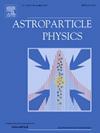拟建的南海深海中微子观测站
IF 2.9
3区 物理与天体物理
Q1 ASTRONOMY & ASTROPHYSICS
引用次数: 0
摘要
在过去的十年里,多信使天文学取得了一些突破。多亏了冰立方中微子天文台,天体物理中微子的探测被证明是可行的。然而,由于有限的统计数据和视野,只有少数来源与冰立方中微子有关,这使得新的和更大的中微子望远镜成为必要。我们建议在南海建立中微子天文台(NEON),作为全球中微子探测器的补充。本提案描述了阵列的设计和布局,并报告了进行综合模拟以评估其性能。NEON项目的体积为10 km3,在100 TeV下实现了0.1°的角分辨率。经过10年的运行,该项目的5σ灵敏度估计为E2Φ ~ 3×10−10 GeV cm−2 s−1,源光谱指数为-2。我们发现1700 ~ 3500米的深度变化对稳定源的灵敏度没有显著影响。本文章由计算机程序翻译,如有差异,请以英文原文为准。
A proposed deep sea Neutrino Observatory in the Nanhai
Over the past ten years, several breakthroughs have been made in multi-messenger astronomy. Thanks to the IceCube Neutrino Observatory, the detection of astrophysical neutrinos was proved to be practical. However, due to the limited statistics and field of view, only a few sources have been associated with IceCube neutrinos, making new and larger neutrino telescopes necessary. We propose the NEutrino Observatory in the Nanhai (NEON), located in the South China Sea to be complementary for the global neutrino detectors. This proposal describes the design and layout of the array and reports on comprehensive simulations conducted to assess its performance. The NEON project, with a volume of 10 km, achieves an angular resolution of 0.1 ° at 100 TeV. With 10 years of operation, the project’s 5 sensitivity is estimated as GeV cm−2 s−1 for a source spectrum index of -2. We found that the variation in depth from 1700 to 3500 meters does not significantly influence the sensitivity to steady sources.
求助全文
通过发布文献求助,成功后即可免费获取论文全文。
去求助
来源期刊

Astroparticle Physics
地学天文-天文与天体物理
CiteScore
8.00
自引率
2.90%
发文量
41
审稿时长
79 days
期刊介绍:
Astroparticle Physics publishes experimental and theoretical research papers in the interacting fields of Cosmic Ray Physics, Astronomy and Astrophysics, Cosmology and Particle Physics focusing on new developments in the following areas: High-energy cosmic-ray physics and astrophysics; Particle cosmology; Particle astrophysics; Related astrophysics: supernova, AGN, cosmic abundances, dark matter etc.; Gravitational waves; High-energy, VHE and UHE gamma-ray astronomy; High- and low-energy neutrino astronomy; Instrumentation and detector developments related to the above-mentioned fields.
 求助内容:
求助内容: 应助结果提醒方式:
应助结果提醒方式:


